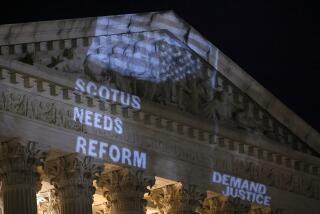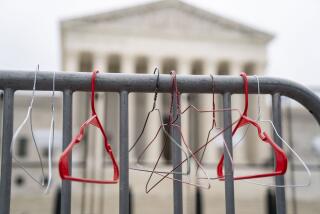Editorial: Judge Barrett showed she was learned in the law; that’s not enough

- Share via
The Senate Judiciary Committee hearings on the Supreme Court nomination of Judge Amy Coney Barrett demonstrated that, as advertised, she is learned in the law and likely to move the court further to the right.
In another universe, her qualifications might incline us to support her nomination despite our concerns that she might vote to undermine the right to abortion or make it harder for Congress and the states to deal with the proliferation of firearms.
But the circumstances in which Barrett has been nominated by President Trump make discussion of her credentials or her judicial philosophy irrelevant. Confirming her now could politicize the Supreme Court beyond the possibility of repair.
One brutal fact overshadows this confirmation process: Some of the Republican senators who are so keen to install Barrett on the court so late in this election year refused in 2016 even to consider President Obama’s nomination of Judge Merrick B. Garland to replace the late Justice Antonin Scalia. The Garland nomination was made in March of an election year, not September.
After Scalia’s death, Senate Majority Leader Mitch McConnell piously insisted that his seat shouldn’t be filled until the people had their say in the presidential election. By the same logic, the successor to Justice Ruth Bader Ginsburg should be appointed by the president elected this year, whether it be Trump or Democrat Joe Biden. More than 17 million votes have already been cast in that contest.
The fact that Republicans are breaking their own rule for political advantage is far more important than anything Barrett said at her confirmation hearings. Still, some of her testimony was troubling.
Like previous Republican nominees, she declined to say how she might rule on a challenge to Roe vs. Wade, the landmark 1973 decision legalizing abortion. But she also wouldn’t opine on whether Griswold vs. Connecticut, a 1965 decision striking down a law that banned the use of contraceptives by married couples, was rightly decided, saying that the only reason to ask the question was “to lay a predicate for whether Roe was rightly decided.” (She also tried to brush back the question by noting that it was “shockingly unlikely” that such a law would be passed today.)
Although Democratic senators raised the question of how Barrett’s confirmation might jeopardize reproductive rights, their primary emphasis was on how she might rule on a challenge to the Affordable Care Act by Republican state attorneys general that will be argued a week after the election.
Given that Barrett could be ruling on constitutional issues for decades, that strategy seemed shortsighted. But it reminded voters about Republicans’ relentless efforts to kill the ACA, even during the COVID-19 pandemic. And it led Barrett to acknowledge that the court could strike down the ACA provision that the lawsuit challenges without invalidating the rest of the law.
The Democrats’ other goal was to portray Barrett as someone who would do the bidding of the president who appointed her, not only in the healthcare case but also in possible disputes over the results of the presidential election. Barrett bristled at the suggestion that “I would allow myself to be used as a pawn to decide this election for the American people.” The problem is that Trump put Barrett in an impossible position when he said before she was nominated that “it’s very important that we have nine justices” to resolve election disputes. For the sake of the court’s credibility, she would need to recuse herself from any case connected to the election.
Despite their pleas for delay, Democrats seem to have recognized that Barrett will be confirmed. The result was a process more decorous than the hearings for Trump’s first two nominees, Neil M. Gorsuch and Brett M. Kavanaugh. But the civility of the proceedings can’t obscure the partisan divide that this nomination has widened.
The Supreme Court’s legitimacy with the public depends on a perception that it is above partisan politics. That image has been sullied by 5-4 decisions in which justices appointed by Republicans are on one side and those appointed by Democrats are on the other. But it’s also marred by the relentless politicization of the Senate confirmation process. Ultimately, the solution may be to reduce the stakes dramatically by giving justices a fixed term on the high court, with the terms staggered so that all presidents will be able to fill at least one seat.
It is no judgment on Barrett’s intelligence or her integrity to point out that if she is confirmed on a party-line vote under these circumstances, the damage to the court could be irreversible. She is being presented with a poisoned chalice.
More to Read
A cure for the common opinion
Get thought-provoking perspectives with our weekly newsletter.
You may occasionally receive promotional content from the Los Angeles Times.










